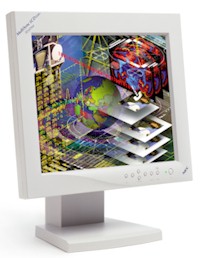|
|


TechnoFILE is copyright and a registered trademark © ® of
Pandemonium Productions.
All rights reserved.
E-mail us Here!

NEC's Multisync LCD 1510 monitorFlat, Bright, Small Footprint by Jim Bray Flat Screen monitors are getting more popular all the time, and this NEC shows why they're great for some applications - and not so great for others, at least not yet. The Multisync LCD1510 is a 15" monitor that performs very well for mainstream applications like office and productivity software. It has a big screen area for a fifteen incher, is bright and sharp, and takes up only a little desk space - leaving room for you to pile lots of other stuff where once your monitor sat. On the downside, it isn't good for fast-moving games or other graphics-intensive applications like drawing and bitmap manipulating programs. Still, for what it is, and at the tasks for which it's designed, it does a good job. Why LCD? Well, besides being perfectly flat (when I first fired it up, the extreme flatness - when compared with my "not as flat" CRT monitor - almost looked concave, which took a bit of getting used to), LCD monitors emit very small magnetic fields (which therefore causes less potential interference with other electronic devices). Not only that, but the smaller "footprint" (the amount of desk space it takes up) and low power consumption can make the monitor easier - and cheaper - with which to live. The fifteen inch screen size, virtually all of which is usable, makes the monitor feel almost like a 17 inch model - and you can't complain about that! Resolution can be set at up to 1024x768, which is high enough for most people's business applications (though not high enough to satisfy my penchant for 1280x1024 which, on my 19 inch monitor, gives me a lot of onscreen room with which to play. I really missed this with the NEC). Another nifty feature about the LCD1510 is its ability to display in either "portrait" or "landscape" modes. Monitors are usually mounted in a "landscape" configuration, which means they're wider than they are high, but the NEC can pivot 90 degrees to become higher than it is wide. This can be nice if you're working on a long Web page or other lengthy document - or need to pack a whole bunch of monitors into a small space. Not a huge deal, perhaps, but a nice bit of flexibility. The monitor also has a nice, wide viewing angle, which can come in handy if more than one person is poring over the onscreen data (for example, a customer and a bank teller). Controls are mounted (as with many monitors) on the bottom front, are clearly labeled and easy to figure out. The NEC uses the usual type of onscreen menus for its various adjustments. Setting up the monitor is easy. It's very light compared with its CRT cousins, and it comes in sections: the monitor itself - including its height-adjustable stand - the separate AC power adapter and the cables. The cables can be run through the stand, which keeps them out of the way - and the setup can also be mounted on a wall for extra flexibility. NEC is targeting the Multisync LCD1510 at financial, medical, manufacturing and transportation industry users, and it would undoubtedly function very well in those environments. Unfortunately, we found the NEC to be not particularly successful for our "home office-oriented" needs - but keep in mind that this isn't the market at which this monitor is being aimed. We do a bit of everything at TechnoFILE, including a lot of graphics tasks and PC game playing (life is tough), and we found the NEC LCD1510 not really up to those tasks. When we used it for more conventional office jobs like word processing, spreadsheet work and that type of thing, however, it was very nice. If only that were all we do here, I might find myself in love with a monitor other than my pet Sony. All of which means that, despite the many clear advantages of this type of monitor (of which this NEC is a lovely example), the technology just isn't there yet for our needs. So it's back to the big, hulking CRT's for us - for now, at least. Darn. It was sure nice having more room on the desk (with which to make it even messier!), and being able to move the monitor around without risking a hernia! Manufacturer's Specifications: LCD Module
|
|
|
|
|
| Support TechnoFile via Paypal |
| TechnoFILE's
E-letter We're pleased to offer our FREE private, subscription-based private E-mail service. It's the "no brainer" way to keep informed. Our Privacy Policy |